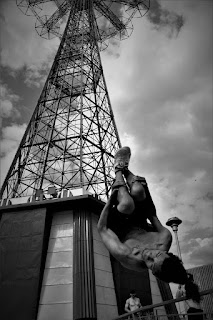Parkour athletes undergo specialized training to develop their agility, coordination, and overall physical abilities. Here are some key components of parkour training:
Conditioning and Strength Training: Parkour athletes focus on developing functional strength, muscular endurance, and overall physical fitness. They engage in exercises such as bodyweight movements, calisthenics, plyometrics, and weightlifting to improve strength, power, and stamina. Training includes exercises for the upper body, core, and lower body to enhance overall athleticism.
Plyometrics and Explosiveness: Plyometric exercises, which involve quick and explosive movements, are essential for developing the explosive power necessary for parkour. Athletes perform exercises like box jumps, broad jumps, and depth jumps to improve their jumping ability, coordination, and reactive strength.
Precision and Balance Training: Parkour requires precise foot placement and excellent balance. Athletes practice precision jumps, which involve accurately landing on specific targets of varying distances. They also train on balance beams, railings, and other narrow structures to improve their balance and body control.
Proprioception and Spatial Awareness: Parkour athletes focus on enhancing their proprioception, which is the awareness of their body's position in space. They perform exercises that challenge their spatial awareness, such as blindfolded movement, navigating through obstacle courses, and practicing complex movements in different environments.
Agility and Quickness Drills: Agility drills play a crucial role in parkour training. Athletes work on quick changes of direction, lateral movements, and reaction drills to enhance their agility and quickness. Cone drills, ladder drills, and shuttle runs are commonly used to improve footwork and agility.
Freerunning Techniques: Freerunning, an expressive form of parkour, incorporates acrobatic movements. Parkour athletes learn techniques such as flips, twists, and tricking elements to add creativity and style to their movement repertoire. These skills require additional training and progressions to ensure safety and proper execution.
Technique Practice: Parkour athletes spend significant time practicing and refining the fundamental movements of parkour, such as vaults, wall runs, cat leaps, and precision jumps. They focus on technique, efficiency, and fluidity of movement, gradually progressing to more complex and challenging combinations.
Safety and Injury Prevention: Parkour athletes emphasize safety and injury prevention. They learn proper landing techniques, rolling techniques, and falling techniques to minimize the risk of injury during high-impact movements. Athletes are encouraged to listen to their bodies, take rest when needed, and practice in controlled environments under the guidance of experienced trainers.
Parkour training is a continuous process of skill development, physical conditioning, and mental focus. Athletes strive to improve their strength, agility, coordination, and spatial awareness to overcome obstacles and move efficiently in any environment. The training methods are diverse, combining elements from various disciplines to create well-rounded and adaptable athletes capable of navigating urban landscapes with creativity and precision.
Photo: Pixabay (free)

No comments:
Post a Comment
Thanks for your comment.